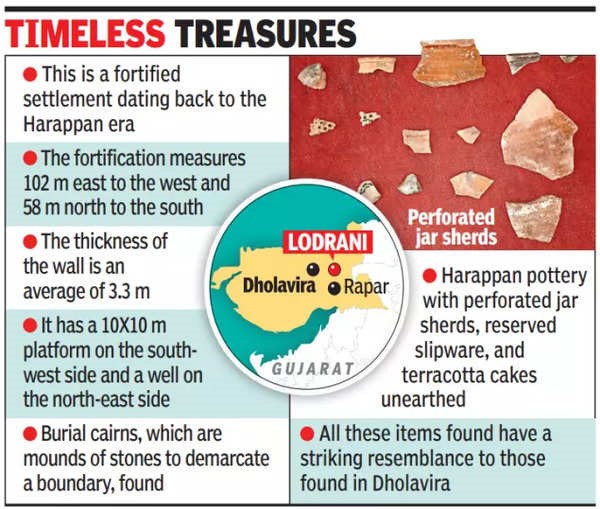





Disclaimer: Copyright infringement not intended.
Context
The discovery of the Harappan-era fortified settlement near Dholavira, named Morodharo, is a significant archaeological find that sheds light on the ancient civilization's expansion and influence in the region.
Details
About Dholavira
Historical Background:
Location:
Urban Layout and Architecture:
Archaeological Finds:
Preservation:
About Harappan Civilisation
Historical Background:
Economy and Trade:
Culture and Society:
Technology and Achievements:
Decline and Disappearance:
Harappan sites:
Harappa:
Mohenjo-Daro:
Sutkagendor:
Chanhudaro:
Lothal:
Kalibangan:
Surkotada:
Banawali:
Rakhigarhi:
|
Site |
Location |
Key Findings |
|
Harappa |
Sahiwal district, West Punjab, Pakistan |
Sandstone statues, granaries, pottery with Indus script, terracotta figurines |
|
Mohenjo-Daro |
Larkana district, Sindh, Pakistan |
Great Bath, Citadel, dancing girl statue, Seal of Pashupati, great granary |
|
Sutkagendor |
Makran district, Balochistan, Pakistan |
Stone vessels, pottery, shell beads, citadel and defensive wall |
|
Chanhudaro |
Nawabshah district, Sindh, Pakistan |
Bead maker’s factory, usage of kajal and lipstick, inkpot, cart impression |
|
Lothal |
Gulf of Cambay/Khambhat, Gujarat, India |
Port and dockyard, citadel, seal with fox story, Mesopotamian seals, rice husk |
|
Kalibangan |
Hanumangarh district, Rajasthan, India |
Double citadel, burnt bangles, fire altars, ploughed fields, camel bones |
|
Surkotada |
Kutch district, Gujarat, India |
Horse bones, stone fortifications, residential complexes |
|
Banawali |
Fatehabad district, Haryana, India |
Well-constructed fort town, barley grains, ivory comb, human figurines |
|
Rakhigarhi |
Hisar district, Haryana, India |
Bronze toys, terracotta statues, granary, traces of cotton cloth |
|
Dholavira |
Kutch district, Gujarat, India |
Stepwell, water reservoirs, dams, chariot sculpture, signboard |
|
Amri |
Dadu district, Sindh, Pakistan |
Evidence of Harappan settlements and artifacts |
|
Alamgirpur |
Meerut district, Uttar Pradesh, India |
Remains of pre-Harappan and Harappan settlement, pottery, artifacts |
|
Balu |
Kaithal district, Haryana, India |
Pottery and artifacts indicating Harappan presence |
|
Balathal |
Udaipur district, Rajasthan, India |
Urban planning, craftsmanship |
|
Daimabad |
Ahmednagar district, Maharashtra, India |
Bronze chariot, urban settlement, artifacts |
|
Desalpur |
Kutch district, Gujarat, India |
Harappan-era remains, pottery, artifacts |
|
Ganeriwala |
West Punjab, Pakistan |
Harappan-era structures and artifacts |
|
Karanpura |
Hanumangarh district, Rajasthan, India |
Harappan-era remains, urbanization, trade |
|
Kunal |
Fatehabad district, Haryana, India |
Pre-Harappan and Harappan settlements, urban planning |
|
Kot Diji |
Khairpur district, Sindh, Pakistan |
Fortified town, craftsmanship, urban life |
|
Kot Bala |
Lasbela district, Balochistan, Pakistan |
Artifacts and structures from the Harappan period |
|
Mehrgarh |
Kachi district, Balochistan, Pakistan |
Earliest agricultural settlements in South Asia, predates mature Harappan period |
|
Mandi |
Muzaffarnagar district, Uttar Pradesh, India |
Harappan presence, pottery, structures |
|
Pabumath |
Kutch District, Gujarat, India |
Harappan-era remains, pottery, structures |
|
Rangpur |
Ahmedabad district, Gujarat, India |
Harappan-era settlement and artifacts |
|
Ropar |
Rupnagar district, Punjab, India |
Harappan presence, pottery, structures |
|
Sanauli |
Baghpat district, Uttar Pradesh, India |
Harappan-era artifacts, evidence of burial practices |
|
Shikarpur |
Kutch district, Gujarat, India |
Harappan-era remains, pottery, structures |
|
PRACTICE QUESTION Q. The Harappan Civilization stands as a remarkable example of early urbanism and human achievement, offering valuable insights into the development of complex societies in the ancient world. Discuss. (250 words) |


© 2025 iasgyan. All right reserved